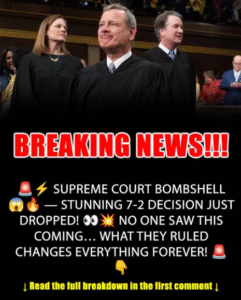Here’s a detailed breakdown of the recent major decision by the Supreme Court of the United States (SCOTUS) — a 7-2 ruling that legal observers are calling earth-shaking.
What Happened
On the decision day, the Court issued an opinion by a 7-2 majority, marking one of the more decisive rulings in recent memory. Specifically:
-
The Court ruled in the case of Advocate Christ Medical Center v. Kennedy, addressing how the Department of Health & Human Services (HHS) must calculate Disproportionate Share Hospital (DSH) payments under the Medicare program. Healthcare Dive+1
-
The hospitals had argued that HHS was undercounting certain low-income Medicare beneficiaries in the DSH formula, thereby depriving hospitals of billions in payments. Healthcare Dive
-
The Court rejected the hospitals’ arguments, siding with HHS’s interpretation of the statute. Justice Amy Coney Barrett wrote the majority opinion. Healthcare Dive
In short: the hospitals lost, the government won — in a solid 7-2 verdict.
Why It’s Significant
1. Financial Implications for Hospitals
Hospitals serving large populations of low-income, Medicare/Medicaid patients rely heavily on DSH payments. The interpretation of the formula affects how much federal reimbursement they receive. The hospitals estimated that HHS’s approach had cost them $1.5 billion per year in some cases. Healthcare Dive
A 7-2 decision means a strong signal: the Court is endorsing the government’s approach, which could shift large sums of funding and budgeting strategies in health-care policy.
2. Precedent for Statutory Interpretation
By siding with HHS’s narrower interpretation, the Court signals how it will read reimbursement statutes and benefit formulas: detailed statutory language matters, and broad equitable arguments may carry less weight. Many health-care providers will now re-evaluate their expectations and legal strategies.
3. Impact on Vulnerable Populations
Because DSH payments fund hospitals that treat high-poverty or disabled populations, this ruling potentially affects access to care. If hospitals receive less federal support, it could impact services, staffing, or viability of safety-net hospitals. The decision thus has downstream effects beyond legal technicalities.
4. Broader Administrative Law Message
Though this case is about health-care payments, it also has implications for how the executive branch interprets statutes and how courts review those interpretations. An unequivocal 7-2 ruling is a weighty signal about deference, statutory interpretation, and the division of power between agencies and courts.
The Opinions: Majority & Dissent
-
Majority (7 justices): The opinion, written by Justice Barrett, held that the hospitals had failed to demonstrate that HHS’s interpretation of the statute was unreasonable. The Court walked through the statutory text, the regulatory context, and prior interpretations — concluding that HHS’s reading was permissible. Healthcare Dive+1
-
Dissent (2 justices): Two justices dissented (not specified here), arguing that the hospitals’ reading better served the statute’s purpose of supporting hospitals with large low-income patient burdens, and that HHS’s approach was overly restrictive or unfair. The dissent underscores that although the majority was decisive, there remains debate about fairness, policy consequences, and statutory fairness.
What’s at Stake Moving Forward
Hospitals Will Reassess
Hospital systems, especially those serving impoverished or disabled populations, will now re-evaluate their financial models and legal strategies. Some may challenge other regulatory interpretations; others may adjust their operations in service of smaller reimbursements.
Congressional Response Possible
Given the financial stakes, Congress may respond. Hospitals and advocacy groups may lobby for legislative correction if they view the ruling as unduly harsh. We may see amendments to the Medicare statute or targeted funding measures.
Real-World Service Impacts
For patients and communities: reduced federal support can translate into fewer services, hospital closures in vulnerable areas, service cuts, or reduced access for low-income patients. Policymakers, hospital administrators, and public-health officials will watch closely how this affects care on the ground.
Legal and Regulatory Ripple Effects
This decision will likely be cited in future cases where agencies interpret statutes and where private parties challenge regulatory formulas or benefit formulas. The 7-2 margin means the precedent is strong — less vulnerable to being overturned or narrowed in future decisions.
The Bigger Picture
This ruling illustrates a broader trend in SCOTUS jurisprudence: strong majorities in complex statutory‐interpretation cases. For regulated entities and the agencies themselves, this means fewer surprises in outcomes and a clearer sense of how the Court is thinking. It also reinforces that the dynamics of administrative law — interpretation, deference, procedural fairness — continue to shape major public policies, not just “headline” constitutional disputes.
From a policy lens, it shows the interconnection between legal doctrine and service delivery: a change in interpretation of a payment formula becomes a tangible difference in how hospitals operate and how patients receive care.
Why People Are Calling This “Earth-Shaking”
The phrase is dramatic, but for hospitals, insurers, public-health officials, and low-income communities, the consequences are very real. A change in the reimbursement formula affects billions of dollars, staffing, and the viability of safety-net institutions. It reshapes the landscape of health-care financing at a national level.
Moreover, the strong 7-2 decision gives stability to the ruling. It means that this isn’t a narrow or tentative precedent — it’s one the Court stands firmly behind. Stakeholders must now plan for a world shaped by this interpretation.
Final Thoughts
In sum: the Supreme Court’s 7-2 decision in Advocate Christ Medical Center v. Kennedy marks a major moment. It’s more than a legal technicality — it’s a shift in how federal statutes get interpreted, how agencies implement complicated formulas, and how hospitals serving low-income Americans are funded.
As the dust settles, payers, providers, legislators, and patients will all feel the ripple effects. The Court has spoken clearly: this interpretation stands. Now the challenge is translating that jurisprudence into policy, planning, and execution.
If you like, I can pull up key excerpts of the opinion, analyze how each justice voted, or show what it means for specific hospitals and states. Would you like that?


